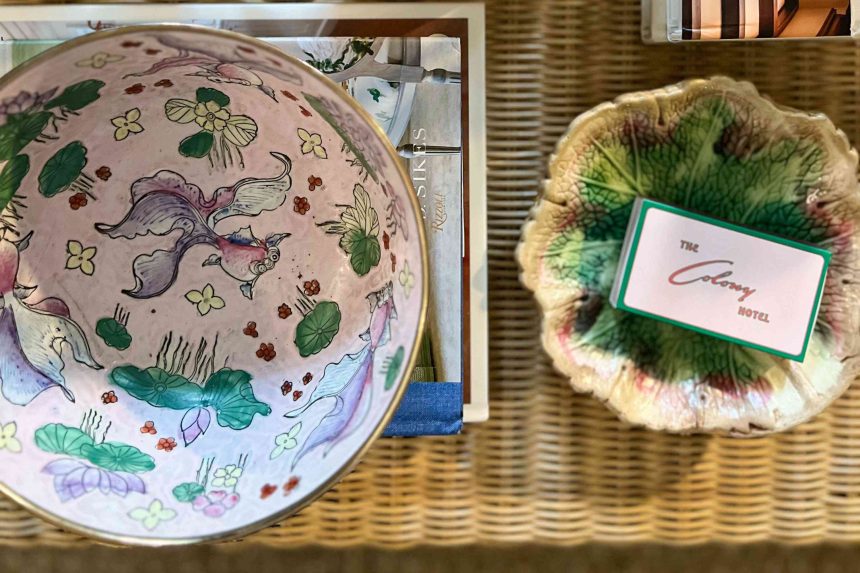Do you remember looking through your grandmother’s shelves as a kid, carefully playing with small brass figurines or arranging small silver trays? Maybe you loved drinking out of the colorful pastel glasses with their signature indentations or making up stories about the rustic characters depicted in folk art panels.
These items were fascinating as a child but, now, they may also hold significant monetary value In addition to their sentimental meaning. You may prefer to hang onto these items because of all the memories they hold, but there’s fun in knowing that they’re now hot on the vintage market.
Curious what top dollar items could be hiding in your grandma’s house? Here’s what design and vintage experts say you should always keep an eye out for and why they love them in their own homes.
Decorative Oyster Plates
When you stumble across an oyster plate at an antique store, don’t be surprised if you let out an audible gasp at the price. “Oyster plates are wildly expensive. Some go for upwards of $1,000 a pop. And let’s be honest, most of us are not actually eating enough oysters to warrant a set of them,” says Virginia Chamlee, an interiors expert and author of Big Thrift Energy, based in Ponte Vedra, Florida.
But this silhouette might look familiar, and it could be because there are oyster plates hiding in plain sight at your grandma’s house. Chamlee explains, “I know a lot of Southern grandmothers with collections of oyster plates and other decorative plates that aren’t even foodsafe, and they look amazing when hung on a wall.”
Majolica Pottery
If you’ve seen richly colored, painted pottery in your grandparents’ house, it might be worth checking to see whether it’s majolica pottery. This valuable pottery has seen a resurgence in recent years, and is a favorite of collectors.
“Majolica is a heavy clay pottery that is coated with enamel, and painted, typically in rich tones, like greens). It’s very collectible and rare but looks so fun as part of a larger tablescape and mixed in with more modern pieces. Or go pure kitsch and just decorate with a whole set of it,” says Chamlee.
Folk Art
Folk art has been popular for centuries, and it’s often been inexpensive to acquire—which is exactly why you’ll find it around many older relatives’ homes. “Folk art—art made by untrained artists—saw a lot of robust interest in the late 20th century after the High Museum of Art in Atlanta began adding it to its permanent collection,” says Chamlee.
Today, these charming pieces are often valuable, and the work extends beyond paintings to folk art pottery, lamps made out of popsicle sticks, fish decoy art, and other rustic mediums.
Virginia Chamlee
Silver
There was a time when owning silver was a rite of passage and, while its panache has decreased in recent year, there’s still inherent value in this precious metal. But that doesn’t mean its primary value is monetary. Cyndy Cantley, the owner of Cantley & Company in Birmingham, Alabama, explains, “I use my grandmother’s silver bowls for everything, filled with oranges at Christmas or nuts. Sometimes I use them even to feed the cat. I truly believe in using everything daily because nothing is too precious.”
Laboratory Beakers
Valuable items can be unassuming, like vintage glassware that once served a functional purpose. Laboratory beakers can be found on a dusty shelf in a thrift shop or in a grandparents’ attic but, cleaned up, they not only look sleek, they can also command a price tag upwards of $30 or more (which is more than you’d imagine for old glass!).
Brooke Droptini, the founder and CEO of LittleCreek+Co in Tyler, Texas, says, “These vintage brown glass laboratory beakers with stoppers were used for sampling and testing in the 1950s-60s. Their sizing makes them perfect for display on open shelving, and nI kept the set together for better presence on the shelf.”
LittleCreek+Co
Wine Storage Jars
A simple vintage wine jar may not look fancy, but these oversized beauties can cost hundreds of dollars on the secondhand market. Droptini added rope to the vintage Italian wine jar she acquired. “Everyone asks where it’s from, but up close, you can tell its patina from use is something you just can’t achieve with a mass-produced item. This one is staying in my personal collection for the foreseeable future,” says Droptini.
LittleCreek+Co
Depression Glass
Depression glass is a favorite of vintage collectors, and it’s often hiding in droves in older relatives’ homes. “This pink depression glass butter dish that I proudly display on open shelving in my kitchen came from my very own great-grandmother. Not only is it stylish, but it’s also functional. For special occasions, it joins my tablescape, adding a touch of nostalgia,” says Droptini, who hopes that one day it will sit on top of the table in one of her young daughters’ homes.
LittleCreek+Co
Wooden Storage Boxes
A handmade wood storage box is something that is passed down through the generations, often humbly finding a spot in a bookcase or atop a dresser. But a beautifully crafted box could be worth hundreds of dollars. “I found a wooden box at an estate sale; I still can’t believe the family let it slip through the cracks. It even has its original lock and key!,” says Droptini. She now uses it to stash remotes and other items she wants hidden out of sight.
Detailed Furniture
While most grandmother’s homes are filled with old furniture, there’s value in the pieces that have intricate detailing and the ability to have a second life with a new owner. “The frame of a chair, ottoman, bench, or sofa that could be recovered for a new look or it could have a specific detail like handmade caning that adds another layer to your space,” says Lucy Harrison, a senior interior designer at SouthPark Interiors in Charlotte, North Carolina
A classic silhouette never gets old, and, as Harrison explains, “They say, ‘history repeats itself.’ There’s fun in taking something that has seen a lot of life and bringing it back to life in a chic, modern way!”
Vintage Rugs
Vintage rugs, particularly those made of 100% wool, are having a moment on the secondhand market. For decades, they were underfoot and overlooked, which is why Darla DeMorrow, a Certified Professional Organizer® and owner of HeartWork Organizing, says, “A high quality rug might be hiding in plain sight.”
She explains that handmade rugs, even after being cleaned between your grandmother’s house and your own, are worth the cost and effort. “Don’t toss one with a little fading or wear; as long as it doesn’t smell, a vintage rug can have great appeal, and that damaged spot can be covered with furniture or another rug,” says DeMorrow.
Fabric
“If grandma kept a stash of interesting vintage fabric, you might be able to turn that into chair covers or custom table linens,” says DeMorrow. Good quality, beautiful fabric is hard to come by, particularly as fabric stores become harder to find, so DeMorrow says a ready-made stash could be a goldmine.
Needlepoint
Did your grandmother spend her time needlepointing canvases that never made it to a finished product? These vintage works of art are the perfect opportunity to create your own high quality pillow or upholstery.
And, if you bought a finished needlepoint retail, it could run into the hundreds of dollars. “I remember visiting my grandmother and always seeing her working on a needlepoint canvas. One of these shell canvases was made into a pillow which now sits on a vintage rattan chair in my dining room,” says Lise Davis, the co-owner of Hunt and Hostess in Winter Park, Florida.
Hunt and Hostess
Assorted China
You never know the value a random piece of china might have, particularly if it’s a particularly desirable pattern (this is where Google Lens can help you!). But, if you don’t want to sell your Tobacco Leaf or Rose, just mix them up for sentimental value. “I was gifted a box of assorted china pieces from my grandmother’s collection,” says Davis. “The escargot dishes in this beautiful shade of green were an odd pairing so instead of discarding, I created interesting gallery wall.”
Hunt and Hostess







